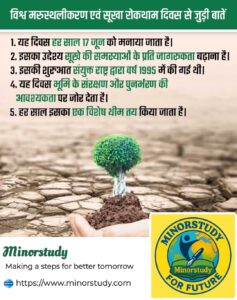🌿 7 Urgent Truths About World Day to Combat Desertification and Drought: A Positive Step Toward a Greener Future
🌱 Introduction: Why This Day Matters More Than Ever
World Day to Combat Desertification and Drought: Every year on June 17, the world observes World Day to Combat Desertification and Drought (WDCDD) — a crucial environmental awareness event with a mission to highlight the urgency of land restoration, climate resilience, and food security.
- 🌱 Introduction: Why This Day Matters More Than Ever
- 📜 History of World Day to Combat Desertification and Drought
- 📅 Timeline of Key Events
- 🌍 12 Powerful Facts About Desertification and Drought
- 🧠 FAQs: What People Often Ask
- ❓ What is desertification?
- ❓ How is drought different from desertification?
- ❓ Why is this day important?
- ❓ What is the UNCCD?
- ❓ How can I observe this day?
- 💥 Significance: Why It’s a Big Deal
- 🕊️ Observance: How the World Participates
- 🎯 Key Themes Over the Years
- 🌺 Wishing on World Day to Combat Desertification and Drought
- 👣 How This Impacts Daily Life
- 🧭 Conclusion: Let the Earth Breathe Again
In a world facing water scarcity, rising temperatures, and deforestation, this day reminds us that healthy land equals healthy lives. From farmers in Africa to city-dwellers in India, desertification and drought are challenges that affect all of humanity, either directly or indirectly.
This is not just an environmental issue — it’s a social, economic, and moral one.
📜 History of World Day to Combat Desertification and Drought
🕰️ How It All Began
In 1994, the United Nations Convention to Combat Desertification (UNCCD) was established.
The UN General Assembly declared June 17 as World Day to Combat Desertification and Drought to commemorate the adoption of the UNCCD.
First observed in 1995, the day has since become a global platform for raising awareness about sustainable land management.
📅 Timeline of Key Events
| Year | Event |
|---|---|
| 1992 | Earth Summit (Rio de Janeiro) – Desertification identified as a major issue |
| 1994 | UNCCD adopted and opened for signature |
| 1995 | First official observance of WDCDD |
| 2006 | Theme: “The Beauty of Deserts – The Challenge of Desertification” |
| 2015 | Linked to SDG 15: Life on Land |
| 2020 | Theme focused on Food, Feed, Fibre |
| 2023 | Campaign highlighted “Her Land, Her Rights” for gender-based land equality |
| 2024 | Theme: “United for Land. Our Legacy. Our Future.” |
🌍 12 Powerful Facts About Desertification and Drought
🌾 Over 2 billion people depend directly on ecosystems in dryland areas.
🌍 75% of the Earth’s land is already degraded or at risk.
🚨 1.5 billion people globally are affected by desertification.
💧 Drought affects over 55 million people every year.
🌡️ Climate change is intensifying both drought and land degradation.
👩🌾 Women in rural areas are disproportionately affected due to land ownership issues.
🍽️ 24 billion tons of fertile soil are lost annually.
🔄 Every $1 invested in land restoration returns up to $30 in economic benefits.
🧒 Children are the most vulnerable to food insecurity caused by land loss.
🏞️ Forests prevent desertification, yet we lose over 10 million hectares annually.
🤝 Over 190 countries are parties to the UNCCD.
💡 Drought is not just a natural event — it’s amplified by poor water and land management.
🧠 FAQs: What People Often Ask
❓ What is desertification?
Desertification is the degradation of land in arid, semi-arid, and dry sub-humid areas due to human activity and climatic factors.
❓ How is drought different from desertification?
Drought is a temporary natural phenomenon marked by lack of rainfall. Desertification is a long-term degradation of land caused by overgrazing, deforestation, and climate change.
❓ Why is this day important?
It raises global awareness about land degradation and encourages actions that prevent or reverse desertification.
❓ What is the UNCCD?
The United Nations Convention to Combat Desertification is the only legally binding international agreement that links environment, development, and sustainable land management.
❓ How can I observe this day?
Through community tree-planting, awareness programs, water-saving practices, and sharing verified information.

💥 Significance: Why It’s a Big Deal
🔬 Environmental Impact
Reversing land degradation helps combat biodiversity loss, soil erosion, and climate change.
Restored lands can store carbon, helping in the fight against global warming.
🍚 Societal Impact
Desertification is a driver of migration, poverty, and hunger.
Land restoration can provide livelihoods, food security, and peace.
🔐 Economic Impact
Investing in degraded land creates jobs, increases crop yield, and prevents losses in agriculture.
Restoration is more cost-effective than dealing with the after-effects of degradation.
🕊️ Observance: How the World Participates
UN and NGOs conduct global conferences, tree-planting drives, and policy forums.
Schools and universities hold quizzes, debates, and exhibitions.
Social media campaigns spread awareness using hashtags like #DesertificationDay, #RestoreLand, #UNCCD.
Local governments may implement water harvesting programs and rural workshops.
🎯 Key Themes Over the Years
| Year | Theme |
|---|---|
| 2020 | “Food. Feed. Fibre.” |
| 2021 | “Restoration. Land. Recovery.” |
| 2022 | “Rising up from drought together” |
| 2023 | “Her Land. Her Rights.” |
| 2024 | “United for Land. Our Legacy. Our Future.” |
Each theme emphasizes a different facet of land conservation — from gender rights to drought resilience.
🌺 Wishing on World Day to Combat Desertification and Drought
🌿 “Let’s pledge today to nurture our planet like we do our home. A single step to save land is a step toward saving humanity.”
🌏 “On World Day to Combat Desertification and Drought, let’s plant hope, preserve soil, and restore dignity to the Earth.”
🌱 “Happy Desertification Day! Let’s make Earth greener, cleaner, and stronger.”
👣 How This Impacts Daily Life
Even if you live in an urban area far from a desert or drought-prone region, here’s how it affects you:
Food Prices: Soil degradation increases costs of food production.
Water Bills: Drought increases dependence on water tankers and supply chains.
Health: Dust and degraded lands increase respiratory and heat-related illnesses.
Climate: Fewer trees and poor land practices worsen climate instability.
Employment: Rural migration due to land loss affects urban job markets.
You can help by:
Practicing rainwater harvesting
Avoiding wasteful irrigation
Supporting sustainable agriculture
Spreading awareness online
🧭 Conclusion: Let the Earth Breathe Again
The World Day to Combat Desertification and Drought is more than a calendar event. It’s a global call to action — reminding us that land is not infinite, but it is renewable if treated right.
Desertification may sound like a faraway issue, but it’s right at our doorstep — in dry gardens, polluted rivers, overused lands, and displaced communities. Each one of us can be a steward of restoration.
Let’s not wait until the green fades to brown.
Let’s act now — for ourselves, for future generations, and for our only home — Earth.









My partner and I stumbled over here by a different website and thought I might check things out.
I like what I see so now i’m following you.
Look forward to exploring your web page again.
Hello great website! Does running a blog similar to
this take a lot of work? I’ve very little expertise
in computer programming however I had been hoping to start my own blog in the near future.
Anyways, should you have any suggestions or tips for new blog owners please share.
I know this is off subject however I just had to ask.
Thanks a lot!
I am not sure where you’re getting your information, but great topic.
I needs to spend some time learning much more or understanding
more. Thanks for wonderful information I was looking for this information for my mission.
omegle style chat best cam chat sites
казіно з бонусами бонусы казино
ORBS Production https://filmproductioncortina.com is a full-service film, photo and video production company in Cortina d’Ampezzo and the Dolomites. We create commercials, branded content, sports and winter campaigns with local crew, alpine logistics, aerial/FPV filming and end-to-end production support across the Alps. Learn more at filmproductioncortina.com
1win зеркало 1win протеин
Хочешь развлечься? купить мефедрон федерация – это проводник в мир покупки запрещенных товаров, можно купить гашиш, купить мефедрон, купить кокаин, купить меф, купить экстази, купить альфа пвп, купить гаш в различных городах. Москва, Санкт-Петербург, Краснодар, Владивосток, Красноярск, Норильск, Екатеринбург, Мск, СПБ, Хабаровск, Новосибирск, Казань и еще 100+ городов.
бонуси в казино бонуси казино
Free video chat emerald chat online find people from all over the world in seconds. Anonymous, no registration or SMS required. A convenient alternative to Omegle: minimal settings, maximum live communication right in your browser, at home or on the go, without unnecessary ads.